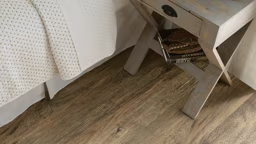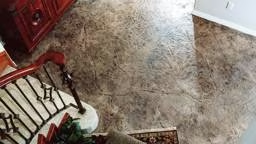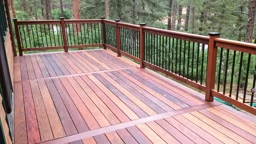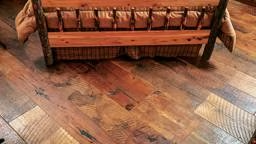Choosing among the vast array of flooring options available is among the most challenging aspects of design planning. Where you may limit types and styles of other building materials through the home, flooring dares you to mix and match, combining the sensible with the fanciful. And when you see the enormous range of flooring options, it just makes it that much more fun. Here, we present some of the hottest flooring options, their pros and cons, and the bottom line.
Table of Contents
Hardwood Flooring

Photo by KWON JUNHO on Unsplash
But even as they continue to lead the parade, there are many new, more unusual species being tapped for use in homes. From South America, Asia and Africa, importers are bringing indigenous cherry, mahogany, teak, cypress, rosewood, and especially bamboo. But even domestic species such as ash, hickory, walnut and pecan are enjoying a renaissance, particularly as manufacturers offer custom work that includes hand-carved borders and center medallion pieces.
It seems the homeowner is limited only by his or her imagination. The old rap against hardwood was its susceptibility to water stains, discoloration and warping, but over time the finishes have improved to such an extent that — with reasonable care — wood is just as at home in the kitchen as any room in the house. Even in the family and recreation rooms, where floors may be subjected to the dreaded toddler stomp, drag and toy-roll test, wood is as viable as any other resource.
See also: Maintaining and Fixing Wood Floors
Reclaimed Wood Flooring
Wood rescued from century-old barns and industrial buildings becomes flooring with unique character. Signs of the wood’s previous life, like saw marks, nail holes and insect scars, add to the appeal of this flooring’s mix of grain patterns and light and dark colors.
See also: 5 Reasons to Buy Reclaimed Hardwood
Wood-Look Flooring
Luxury-vinyl planks offer the look of wood floors with the added benefit of being scuff, scratch and water resistant. Some even come with textured surfaces that mimic the real deal. A less convincing option — but one that has perks of its own — is economical laminated-wood flooring. Made by placing an image of wood on top of fiberboard, it tends to feel softer and warmer than its rivals.
Learn even more about wood and wood-look flooring here.
Bamboo Flooring
Perhaps the newest product to hit the market in the past two years is bamboo flooring. Bamboo is a naturally soft material. After processing, however, the product looks and feels much like pre-finished hardwood flooring and is installed in a manner similar to laminate flooring products.
Because it grows so rapidly and can be harvested without killing the plant, bamboo qualifies for the rapidly renewable resource credit in the U.S. Green Building Council’s LEED program. If bamboo flooring is manufactured without using urea-formaldehyde binders, it also qualifies for an indoor air quality credit. These characteristics are responsible for bamboo’s reputation as a “green” product.
You’ll typically find bamboo in either flat-grained or edge-grained flooring. Flat-grained floors show the bamboo’s “knuckles.” (If you’ve ever seen a bamboo pole, you’ve noticed the periodic swelling along the cane. These are the knuckles.) Edge-grained bamboo doesn’t show the knuckle patterns. Bamboo flooring has two natural colors: a blond similar to maple flooring, and a deeper brown (the latter is the result of a heat-treating process). Bamboo also can be stained.
If building green is an important goal (and I think it should be), be prepared to do some research and make some tradeoffs. Keep in mind that almost all bamboo flooring comes from China, where environmental controls on its growth and harvest vary widely. China currently doesn’t allow inspections of how bamboo is grown, harvested and processed, which means that it’s hard to tell if environmentally friendly methods and materials have been used. (By the way, it’s a myth that the bamboo used in flooring exhausts the food resources for China’s endangered giant pandas.) Before you buy bamboo flooring, learn from the manufacturer if urea-formaldehyde binders were used in its creation, and find out how it was transported to our shores. If efficiency wasn’t considered, then buying this type of flooring will do more harm than good
Fiber Flooring
The term can be confusing as “fiber flooring” is applied to describing a wide range of materials all the way from carpet to what might have been called linoleum in years gone by. All are distinguished from other types of flooring in that they are made from natural, fibrous materials. This includes sisal or jute carpet. It also may be a roll-out, 12-foot-wide material that looks like wood floor or even stone, depending on the pattern. However, the materials are usually very resistant to damage, and most (but not all) come from green, or earth-friendly, resources. (Look for a FSC Certification label to ensure environmental claims are accurate.) Depending on the finish, fiber flooring can also be relatively easy in maintenance and cleaning.Rugs and Carpeting
Carpeting has been resurrected from the low-rent bin to covering floors in some of the loveliest homes imaginable. Carpeting never lost its appeal as a warm, comforting surface. In cooler climates, where rugs never did go out of style, that wrap-in-comfort charm has returned in the form of natural fibers (if cost is not the determining factor) or nylon (when durability counts). After being exiled to the bedroom, carpets and large rugs are rolling back out into great rooms, dining rooms and libraries across the spectrum.Tile and Stone Flooring
Tile
Tile, of course, covers a range of materials. Some of the popular options we'll explore in-depth are stone, ceramic and porcelain. One interesting development when it comes to tile flooring is the newfound ability to heat tiles for warmth. In some systems, a mesh-backed mat is embedded directly into the cement for the tile (or in some instances, even stone). A heating cable is then affixed that allows for warmth at the flick of a switch, and it’s a simple enough procedure that many do-it-yourselfers can tackle the project. Additionally, new manufacturing processes are allowing companies to offer tile that is substantially more resilient and resistant to scratches than ever before. Foam backing also protects against moisture and stains from the bottom while adding comfort.
Stone
Stone has been used as flooring since ancient times, but never has it been a more convenient choice than it is today. Popular for floors from the foyer to the family room, stone flooring will last as long as the house, if not longer. The current trend is toward marble, granite, slate and limestone. Polished marble and granite create an air of formality that probably isn't the atmosphere you want in an inherently casual family room, but it may be entirely appropriate for a foyer. Slate, which creates an informal mood, may be just the right choice for the casually decorated timber frame house. Limestone is a particularly popular choice these days, especially for the kitchen.
For safety, many designers urge home owners to stay away from flooring composed of polished stone. They often recommend a rougher finish achieved by honing or tumbling. Honing is the process of grinding the stone flat but not polishing it. A tumbled finish is exactly what it sounds like: The stone has been tossed in a huge container to crack off sharp edges and scruff up the material. Picture pieces of stone being tossed around in an industrial-strength clothes dryer. Other slip-resistant finishes also are available. For instance, sandblasting stone yields a textured finish, as does searing it with a torch. Slate offers a naturally textured finish in that it can be split into layers.
Ceramic
Ceramic tile is a long-time favorite of home owners because of its durability. Ceramic tile comes in a variety of styles, some even mimicking stone. The array of sizes is equally great, making ceramic tile suitable for everything from finishing a large room to creating a small border. Large tiles measuring 1 square foot make a room appear large, but smaller ones are safer to walk on because they require more grout. This is a legitimate concern, especially when finishing bathrooms and kitchens where spilled water can cause falls and injuries. Like stone, ceramic tiles with matte or textured finishes enhance slip-resistance, as do unglazed tiles, although they'll need to be resealed annually.
Walking through the ceramic section of your local tile shop is like peering into a kaleidoscope — colors and patterns abound. Tiles are water resistant, making them a popular option for kitchens, bathrooms and basements. Plus they’re the most affordable tile option on the market. But their affordability does come with drawbacks: Ceramic tile is prone to chipping, cracking and scratching.
Porcelain
A step above ceramic tile in terms of appearance and performance, porcelain looks more refined (due to having fewer impurities) and is distinguished from ceramic tile by its superior resistance to water. But it isn’t all work and no style: Tiles come in an array of colors and patterns from subtle and serene to bright and bold.Marmoleum
Cork
Concrete

This dramatic polished concrete flooring is from Craftsman Concrete in Austin, TX. Photo: courtesy Craftsman Concrete
Even concrete is becoming popular. It can now be colored or stained to almost any hue, while patterns and textures are virtually limitless. In warmer climates, concrete can hold coolness and help the air conditioning bill considerably. In cooler areas, in-floor radiant heat means you’ll not be able to tell the difference from other types of flooring. Glass can be added to the original concrete pour, then polished when dry to create an exciting, brilliant finish. Overlays can be done later to almost any concrete source to change the appearance or finish, or to correct fissures.
Flooring Options: Frequently Asked Questions
1. What are the most important things I should consider when buying flooring materials?
First, remember that flooring is about more than just good looks. Indeed, budget, wear, health, comfort and maintenance all figure into your choices. If you’re a do-it-yourselfer, you can add installation requirements such as tools and experience to the list.Wall-to-wall carpet offers the most economical alternative in most situations, and lower grades of vinyl run a close second. As you might guess, ceramic tile, slate, marble or exotic hardwoods occupy the high end of the cost range.
To get a better handle on budget, mark up a copy of your floorplans to show the type of flooring for each area of the house — then add up the square footage for each room. From there, visit flooring suppliers to obtain installed costs for each type of flooring you’re considering. Add 10 to 15 percent for waste and taxes.
2. Since my home’s budget is tight, what are the best options for flooring in moderate-traffic areas?
Moderate-traffic areas like hallways, living and dining rooms benefit from sturdy carpeting. Because carpet is easy to remove, it’s a good choice in areas you may wish to re-cover with hardwood later. Berber carpeting wears well and, at least when compared to longer loop or shag, is easy to clean. If carpeting is your short-term solution, treat the area and prepare it as if the hardwood is going in now. Set door heights and trim as if the floor will be hardwood. This will save time and money when you actually install the pine or oak floors you crave.Adhesive-backed vinyl tile — most of which you can install yourself — usually provides the most affordable option. Basements and mudrooms are always great places for vinyl. You also can paint or apply an epoxy coating for an easy, inexpensive finish to concrete. If you’d like concrete to be used as a finished floor, be sure and tell the concrete finishers. Unless told otherwise, many finishers simply sweep the damp concrete to give a “broom finish” that won’t be slippery when wet but won’t have the smooth, finished look you associate with decorative concrete floors. You also can have the concrete subcontractor color the concrete. A couple coats of sealer on dyed or colored concrete provides an attractive floor for utility and basement areas.
3. What types of things do I need to think about when it comes to wear and tear in high-traffic areas?
Hardwood flooring usually works best in areas of the house where the traffic is most intense. Be careful of softwood flooring such as pine, which will scar easily from things like pet claws. Finish hardwood flooring with several coats of a polyurethane varnish — the kind that’s used to finish commercial and gymnasium floors. If you anticipate heavy traffic to and from the outdoors, make sure you have an all-weather floor covering just inside exterior doors. Make this covering large enough for people to remove boots and coats and dry opened umbrellas. Slate, ceramic tile and heavy-duty vinyl will work well, but be sure they have a non-skid surface. Slick ceramic tile sometimes can send a running child or pet slipping and sliding into a nasty fall.4. I've seen all kinds of flooring materials used in the kitchen — from ceramic tile to slate — but I worry about keeping it clean.
What are some flooring materials that both look good and can endure the traffic, spills and bumps that are part of life in the kitchen? Kitchen floors present special challenges. They should look good, clean easily, resist stains from spills and dents from dropped kitchenware, and be comfortable to stand on for long periods of time. Ceramic tile and slate create striking kitchen floors. If properly sealed, they’ll resist stains and clean easily. Of course, there are drawbacks: The floors tend to be cold, and grout joints are notoriously difficult to keep clean even when sealed repeatedly. Heavy-duty vinyl imitates the look of slate and tile and is a breeze to clean. Another option: high-quality vinyl, which installs easily for do-it-yourselfers.5. We’re installing radiant-floor heating in our home. Does one type of flooring material complement this technology better than another?
Yes, your flooring choices will have an impact on the efficiency of a radiant-floor system. Concrete and gypcrete (gypsum-based concrete) provide excellent mass for storing and radiating heat from fluid carried through embedded tubing underneath the floor. Concrete’s high density helps moderate temperature swings so the radiant system doesn’t have to continually re-adjust for temperature fluctuations in the core.However, radiant-floor heating isn’t limited to concrete floors. Most systems can be used with any floor covering. In fact, your contractor can install special subflooring that contains grooves for the tubes and thermal-deflection material used in radiant-floor heating. The grooves direct heat upward through the flooring. (Note: The benefits of the system’s heat transfer will be lost if you use high-density flooring like carpeting or cork.)
When it comes to hardwood flooring and radiant heat, be sure your contractor acclimates the wood thoroughly. (Actually, you should do this no matter what type of heating you use.) Move the flooring into the area where it will be installed and leave it for several weeks with the HVAC system running. This will help eliminate shrinkage and unexpected wood movement.











_11868_2023-08-16_08-47-256x288.avif)






